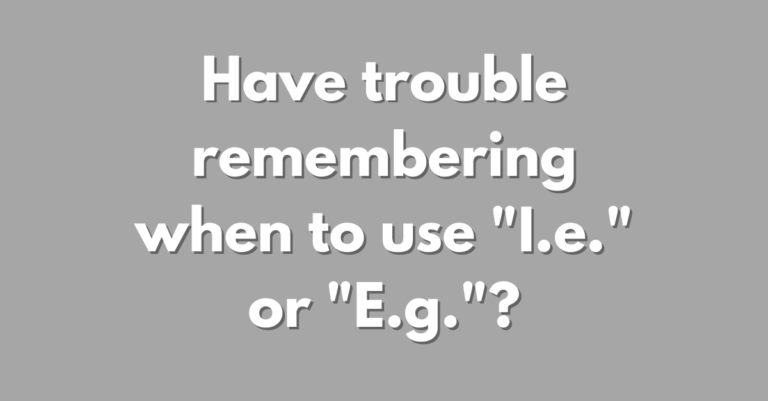Misusing the abbreviations “i.e.” and “e.g.” was one of the top mistakes I used to see when I edited technical documents. There’s so much confusion that in some of the drafts I got back from clients they had actually crossed out the right abbreviation and replaced it with the wrong one. And I just had to laugh. And fix it.
What do ‘i.e.’ and ‘e.g.’ mean?
“I.e.” and “e.g.” are both abbreviations for Latin terms. “I.e.” stands for “id est” and means roughly “that is.”
“E.g.” stands for “exempli gratia,” which means “for example.”
“Great. Latin,” you’re probably thinking. “How am I supposed to remember that?”
How to remember the difference between ‘i.e.’ and ‘e.g.’
Well, by now, you probably know I’m not going to ask you to remember Latin. I’m going to give you a memory trick! So here’s how I remember the difference:
Forget about “i.e.” standing for “that is” or whatever it really means in Latin. From now on, “i.e.,” which starts with I means “in other words.” And “e.g.,” which starts with E, means “for example.” I = in other words. E= example
A few listeners have also written in to say that they remember the difference between “i.e.” and “e.g.” by imagining that “i.e.” means “in essence,” and “e.g.” (“egg”) sounds like “egg sample,” and those are good memory tricks too.
So now that you have a few tricks for remembering what the abbreviations mean, let’s think about how to use them in a sentence.
“E.g.” means “for example,” so you use it to introduce an example: “I like card games, e.g., bridge and crazy eights.” Because I used “e.g.,” you know I’ve given you a list of examples of card games I like. It’s not a finite list of all card games I like; it’s just a few examples.
On the other hand, “i.e.” means “in other words,” so you use it to introduce a further clarification: “I like to play cards, i.e., bridge and crazy eights.” Because I used “i.e.,” which introduces a clarification, you know that these are the only card games I like.
And as an aside, you don’t capitalize the names of old-time card games like that. “Poker” and “rummy” are also lowercase. If you’re writing about a game that is a brand name, like Uno or Magic: The Gathering, those are capitalized because they’re names — proper nouns.
But back to “i.e.” and “e.g.,” here are two more examples:
First: “Squiggly has always had big dogs as pets (e.g., bullmastiffs and Great Danes).” The words following “e.g.” are examples, so you know that these are just some of the big dogs Squiggly has had as pets.
Now compare that to this:
“Squiggly has always had big dogs as pets (i.e., bullmastiffs and Great Danes).” The words following “i.e.” provide clarification: they tell you the names of the only big dogs Squiggly has had as pets.
Now, an important point is that if I’ve failed, and you’re still confused about when to use each abbreviation, you can always just write out the words “for example” or “in other words.” There’s no rule that says you have to use the abbreviations.
Dos and don’ts for ‘i.e.’ and ‘e.g.’
Next, if you’re wondering how to write these abbreviations, don’t italicize “i.e.” and “e.g.” Even though they’re abbreviations for Latin words, they’ve been used for so long that they’re considered a standard part of the English language.
Also, remember that they’re abbreviations, so there is always a period after each letter.
Also, I always put a comma after ‘i.e.” and “e.g.” I’ve noticed that my spell checker always freaks out and wants me to remove the comma, but six out of seven style guides recommend the comma. Seriously. I got so engrossed in the question of whether a comma is required after “i.e.” and “e.g.” that I made a table for the website summarizing the opinions of seven different style guides.
| Source | Recommendation |
| Chicago Manual of Style | In formal writing, … confine i.e. and e.g. to parentheses or notes, where they are followed by a comma. |
| AP Stylebook | [I.e. and e.g. are] always followed by a comma. |
| Blue Book of Grammar and Punctuation | Commas are preferable/optional after the abbreviations. |
| The Columbia Guide to Standard American English | [Editors] require a comma after the second period [in these abbreviations]. |
| The Guide to Grammar and Writing | The comma [following i.e. and e.g.] makes good sense. |
| Lynch Guide to Grammar | Both abbreviations should be followed by a comma. |
| Fowler’s Modern English Usage | Commas do not usually follow i.e. (No comment on e.g.) |
For what it’s worth, I’ve also been told that commas are used less frequently in British English, and the only style guide I found that advised against commas was Fowler’s Modern English Usage, which has its roots in British English. The bottom line is that in American English, I recommend using a comma after “i.e.” and “e.g.”
Finally, I tend to reserve “i.e.” and “e.g.” to introduce parenthetical statements, but it’s also perfectly fine to use them in other ways. You can put a comma before them, or if you use them to introduce a main clause that follows another main clause, you can put a semicolon before them. You can even put an em dash before “i.e.” and “e.g.” if you are using them to introduce something dramatic. They’re just abbreviations for words, so you can use them in any way you’d use the words “in essence” or “for example.”




